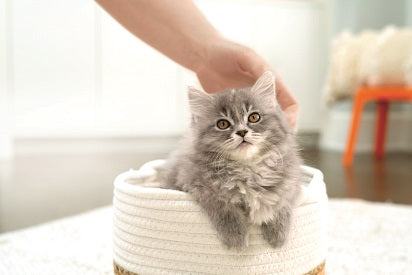- Regular
- $19.99
- Sale
- $19.99
- Regular
- $19.99
- Unit Price
- per
💥💥💥*****HOLIDAY SHIPPING DEADLINES. PLEASE REVIEW THE SHIPPING ESTIMATES PER EACH ITEM. EACH VENDOR HAS DIFFERENT DEADLINES.******💥💥💥

Bringing home a new kitten is an exciting time for your customers. However, it can also be overwhelming trying to decide what they need to get started. As the president of a rescue group, I know helping new kitten parents get off to a good start is not only critical to the kitten’s health and well-being, but can determine whether the introduction into a new home is a successful one.
A Kitten-Safe Space
The best thing your customers can do for a new kitten is to introduce them to their home slowly. A change in environment is scary for kittens. Therefore, starting them off in a small space like a bathroom, laundry room, or unused bedroom gives the kitten a manageable space they can call their own. For skittish kittens, we recommend somewhere that doesn’t have places the kitten can “disappear,” like under a bed or behind a dresser. That said, it is a great idea to give kittens somewhere they feel safe, whether it’s an igloo-style bed or a cardboard box they can hide in.
After a few days, when the kitten is comfortable in this new space, pet parents can gradually introduce them to new areas of the house.
Kitten Supplies
The amount and types of cat products on the market can not only overwhelm, but can also break the budget. If you want customers to keep coming back to the store, resist the urge to sell them everything at once. At the rescue, we recommend a starter-shopping list that includes:
Focus on Nutrition
To avoid gastrointestinal issues, it’s better to keep a new kitten on the same diet he or she was on at the breeder, rescue, or shelter. At my rescue, we use Purina products because they not only meet kittens’ nutritional needs, but their different lines meet the varied budget needs of our adopters. Purina One and Purina Pro plan have both a dry kibble and canned options, while Fancy Feast comes in a canned only, and Purina Kitten Chow comes in dry only.
When pet parents want to change a kitten’s food, encourage them to do it gradually to avoid tummy troubles. Additionally, Purina recommends customers look for foods that have:
Finally, Purina nutritionists recommend feeding kittens both wet and dry food as it ensures cats get plenty of moisture in their diet from wet food while the crunchy kibble in dry food helps reduce plaque and tartar buildup.
“Providing both types of food during the day also adds variety to keep cats interested as they are neophilic and appreciate trying new things,” said Joe Toscano, vice president of trade and industry development at Purina. “It also helps kittens develop their palates by preventing them from exclusively preferring a single type of food over time. The more variety in a kitten’s diet, the more adaptable they become to diet changes the older they get.”
For additional information and tips, visit Purina’s Guide to Getting a Kitten
Original story from Pet Age, 08012021
0 Item(s)